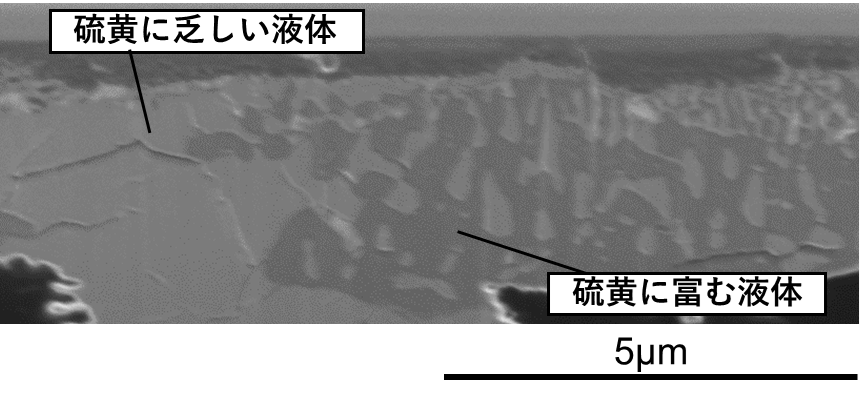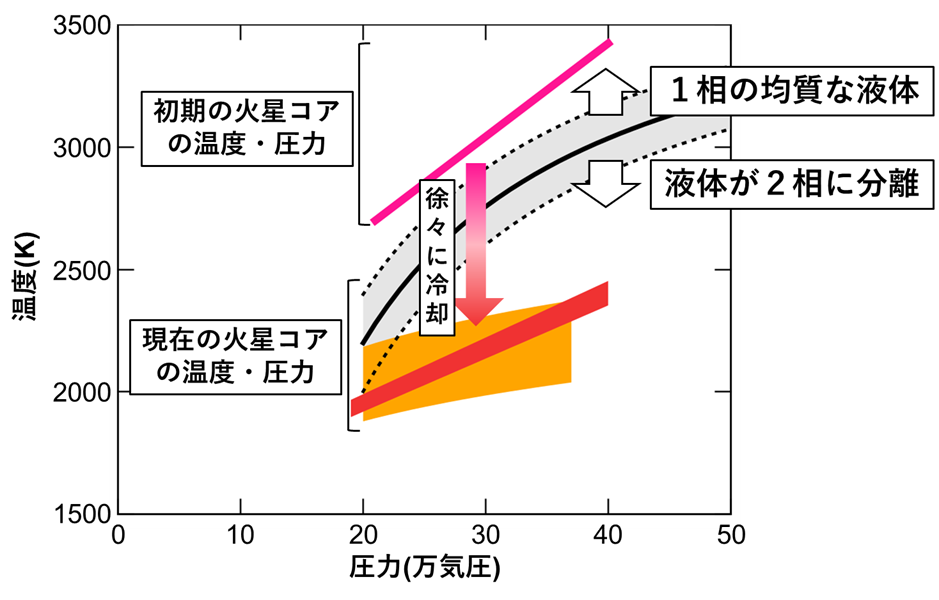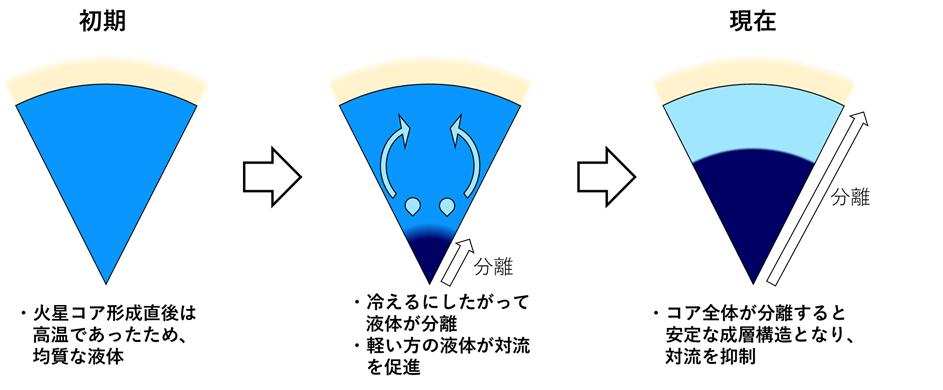DATE2022.02.03 #Press Releases
Liquid metal separates in the Martian core.
Disclaimer: machine translated by DeepL which may contain errors.
~Toward understanding the causes of the disappearance of the Martian magnetic field and the evaporation of the oceans
Shunpei Yokoo (Department of Earth and Planetary Science, 1st Year Doctoral Student)
Kei Hirose (Professor, Department of Earth and Planetary Science / Director and Professor, Institute for Earth and Life Science, Tokyo Institute of Technology)
Key Points of the Presentation
- By combining the world-leading ultrahigh-pressure and high-temperature generation technology of this research group with experiments using synchrotron radiation X-rays from the SPring-8 large synchrotron radiation facility, we have succeeded in the world's first melting experiment of iron alloys containing sulfur and hydrogen under high-pressure and high-temperature conditions equivalent to those on Mars and Earth cores. Detailed observations of the experimental samples revealed that the iron-sulfur-hydrogen alloy separates into two liquids in the Martian core: a sulfur-rich liquid and a hydrogen-rich liquid (like water and oil).
- These results suggest that the separation of the liquids in the Martian core during cooling drove and subsequently suppressed convection in the core, leading to the generation and loss of the Martian magnetic field, which existed until about 4 billion years ago. The loss of the magnetic field is thought to have resulted in the dissipation of hydrogen from the Martian atmosphere into space, as well as the evaporation of the Martian oceans.
- This scenario of the disappearance of the Martian magnetic field and oceans is expected to be further validated by the ongoing observations of NASA's Mars InSight spacecraft and other data.
Summary of Presentation
A research group led by Shunpei Yokoo, a Doctoral student in the Department of Earth and Planetary Science, Graduate School of Science, The University of Tokyo, and Professor Takashi Hirose has used the large synchrotron radiation facility SPring-8 (Note 1) to clarify the existence state of liquid iron-sulfur-hydrogen alloy under high pressure and temperature, which is likely to constitute the Martian core (Note 2). The study revealed the existence of liquid iron-sulfur-hydrogen alloy under high pressure and high temperature.
Traditionally, the Martian core has been thought to be composed of sulfur-rich liquid iron. However, recently reported results from an interior structure survey by NASA's Mars Interior Orbiter Insight (Note 3) indicate that the Martian core is less dense than previously predicted and may contain a large amount of hydrogen in addition to sulfur. However, the behavior of liquid iron-sulfur-hydrogen alloys under high pressure has not been investigated.
In this study, by combining ultrahigh-pressure and high-temperature experiments using the laser-heated diamond anvil cell (LH-DAC) (Note 4) with X-ray diffraction at the beamline BL10XU of SPring-8 and cross-sectional observation of recovered samples using a focused-ion beam (Note 5), we have investigated the behavior of iron-sulfur-hydrogen alloy when it was liquid under ultrahigh pressure and high temperature. The results show that at sufficiently high temperatures in the Martian core, the liquid iron-sulfur-hydrogen alloy exists as a single homogeneous liquid, whereas at lower temperatures it separates into two phases, a sulfur-rich liquid and a hydrogen-rich liquid.
The conditions under which the liquid iron-sulfur-hydrogen alloy separates into two phases coincide with the present-day pressure and temperature conditions of the Martian core. Mars had a magnetic field until about 4 billion years ago, but it is known to have been lost since then, and the cause of this loss has been a great mystery. The loss of the magnetic field is also thought to have led to the dissipation of hydrogen in the Martian atmosphere into space and the evaporation of the oceans. The results of this study indicate that the separation of the Martian core into two phases during cooling drove convection in the core, which is necessary for the generation of planetary magnetic fields in the early stages of Mars, to produce a magnetic field, and that the further separation of the two phases likely led to the subsequent suppression of convection and disappearance of the magnetic field. Further clarification of the conditions of the Martian core through observations by NASA's Mars Interior Orbiter INSIGHT is expected to verify the validity of such a scenario of Martian magnetic field formation and extinction and greatly advance our understanding of Martian history.
Contents of Presentation
Background
Studies of magnetic fields recorded in the Martian crust indicate that Mars had a strong planetary magnetic field until about 4 billion years ago. The disappearance of the planetary magnetic field is thought to have caused hydrogen in the atmosphere to dissipate into space, leading to the dissociation of water vapor into hydrogen and oxygen, which eventually vaporized the oceans. So the big mystery is how the magnetic field was lost on Mars, unlike on Earth. It is believed that the magnetic field of terrestrial planets is created by electromagnetic induction due to convection in the liquid core. To solve this mystery, it is necessary to clarify why convection occurred in the Martian core and why it stopped.
The metallic cores of terrestrial planets such as Earth and Mars are thought to contain lighter elements (light elements) in addition to iron and nickel. Mars cores, in particular, are believed to contain large amounts of sulfur based on studies of Martian meteorites, with estimates ranging from a few percent to more than 20 percent by mass. However, unlike on Earth, the composition and structure of the interior of Mars have not been determined due to the lack of seismic surveys of the interior. In order to investigate the structure of the interior of Mars, NASA's Mars Interior Orbiter INSIGHT has recently conducted an interior structure survey, and in 2021 reported the results of seismic detection of the Martian core. In the report, it was revealed that although a liquid core exists on Mars, its density is smaller than previously predicted and that light elements other than sulfur are also present in the core.
It is thought that during the formation of the planets in the solar system, much water was transported to Earth from the present-day asteroid belt or even from the outer regions of the asteroid belt. Since Mars is much closer to the asteroid belt than Earth, a large amount of water must have been brought to Mars as well. In that case, hydrogen is considered one of the leading candidates for light elements in the Martian core because of its property of being easily incorporated into iron under high pressure. However, due to experimental difficulties, few experiments have been conducted to study the state diagram of an iron-sulfur-hydrogen alloy that simulates the Martian core (i.e., a diagram showing the states of the system depending on conditions such as temperature, pressure, and composition). Previous studies conducted under high pressure have been limited to experiments on solids and have not directly discussed the Martian core, which has been shown to be liquid.
Research Details
A research group led by Professor Kei Hirose of the Department of Earth and Planetary Science, Graduate School of Science, The University of Tokyo has been a world leader in ultrahigh-pressure and high-temperature generation technology using the laser-heated diamond anvil cell (LH-DAC). In experiments using the LH-DAC, high temperatures high enough to melt iron can be generated under high pressures equivalent to those found in the interior of the Earth or Mars. In addition, X-ray diffraction at the BL10XU beamline at SPring-8 has made it possible to measure the hydrogen concentration in iron under high pressure, which cannot be measured under atmospheric pressure. In addition, the group's focused ion beam microfabrication allows detailed observation of the structure of samples recovered after experiments, which is important for interpreting the state of existence of liquids. Using these techniques, a research group led by Shunpei Yokoo, a Doctoral student in the Department, and Professor Takashi Hirose has successfully performed melting experiments of iron-sulfur-hydrogen alloys under high pressure.
Cross-sections of samples recovered at atmospheric pressure after the melting experiments revealed the existence of a single phase liquid with a homogeneous distribution of both sulfur and hydrogen in samples heated to temperatures above 3000 K at 40 GPa (equivalent to the pressure at the center of the Martian core). At lower temperatures, however, the liquid was divided into two distinct compositions, showing evidence of sulfur and hydrogen concentrations on different sides (Figures 1 and 2).

Figure 1: Elemental mapping of cross sections of samples with (left) and without (right) liquid separation.

Figure 2: Mixture of separated liquids photographed by the focused ion beam.
This indicates that the liquid iron-sulfur-hydrogen alloy separates into a sulfur-rich liquid and a hydrogen-rich liquid at high pressure and with decreasing temperature. Similar experiments were performed at different pressures and temperatures, and it was concluded that the pressures (about 20-40 GPa) and temperatures (about 2000-2500 K) estimated for the present Martian core coincide with the conditions under which this liquid alloy would separate (Figure 3).

Figure 3: Temperature and pressure of the present-day Mars core (red and orange) and the early Mars core (pink). At temperatures above the black line, the liquid iron-sulfur-hydrogen alloy is a homogeneous one-phase liquid; below the temperature of the black line, it separates into a two-phase liquid.
The early Martian core, just after the formation of Mars, was probably hotter than it is today. When the Martian core, which was a homogeneous one-phase liquid under high temperatures, begins to cool, it separates into two liquids, with the heavier liquid accumulating near the bottom. The lighter liquid then floats up and promotes convection in the Martian core, which generates a Martian magnetic field. However, when cooling is sufficiently advanced to separate most of the core into two phases, a gravitationally stable stratification structure (the heavier the liquid, the lower the stratification structure) is formed, which in turn suppresses convection in the core and causes the Martian magnetic field to disappear (Figure 4). Thus, the results of this study reveal the mechanism of both the generation and disappearance of the magnetic field on Mars.

Figure 4: Schematic of the enhancement and suppression of core convection by liquid separation.
Significance and Future Prospects
This study proposed a mechanism that likely caused the formation and disappearance of the Martian magnetic field as well as the evaporation of the oceans. This scenario assumes that the Martian core contains large amounts of hydrogen in addition to sulfur. Like on Earth, water on Mars would have come from regions where H2O condensed as ice from the primordial solar disk gas (regions more than 2.7 AU from the Sun). Because Mars is farther from the Sun than Earth, it is likely that more water was transported to Mars than to Earth. It is quite possible that such a large amount of water could have been the source of hydrogen in the Martian core.
Currently, NASA's Mars Interior Orbiter INSIGHT is revealing more details about the structure of the Martian core. In the future, if we can confirm whether hydrogen is present in the Martian core and whether density stratification (the presence of heavy liquid at depth) still exists today, we will be able to verify the scenario of this study. In addition, interpretation of the detailed structure of the Martian core using the results of this study is expected to reveal the material materials that made Mars and the planet formation process.
Journals
-
Journal name Nature CommunicationsTitle of paper Stratification in planetary cores by liquid immiscibility in Fe-S-HAuthor(s) Shunpei Yokoo, Kei Hirose, Shoh Tagawa, Guillaume Morard and Yasuo OhishiDOI Number 10.1038/s41467-022-28274-z Abstract URL https://www.nature.com/articles/s41467-022-28274-z
Terminology
Note 1: SPring-8, a large synchrotron radiation facility
The name SPring-8 is derived from Super Photon ring-8GeV. At SPring-8, a wide range of research is being conducted using synchrotron radiation, from nanotechnology and biotechnology to industrial applications. ↑up
Note 2: Mars Core
At the centers of the Earth and Mars, there is a region called the core, which is mainly composed of iron. Recent studies have shown that Mars has a liquid core with a radius of about 1830 km. The Martian core is thought to be sulfur-rich, but its detailed chemical composition is not known. ↑up
Note 3 Mars Interior Explorer INSIGHT
A probe developed by the National Aeronautics and Space Administration (NASA) for deep exploration of Mars. The name InSight is derived from Interior Exploration using Seismic Investigations, Geodesy, and Heat Transport. It is equipped with a seismometer and a heat flow meter, and has already succeeded in detecting the core through seismic observations of Mars. ↑up
Note 4: Laser Heated Diamond Anvil Cell (LH-DAC )
The diamond anvil cell is a small, palm-sized ultrahigh pressure generator that uses diamonds as the lancet-shaped component (anvil) that generates pressure. A small hole is made in a metal plate called a gasket, and a sample is placed in the hole and sandwiched between two diamond anvils to generate high pressure. By irradiating a laser beam through the diamonds in this state, the sample can be brought to a high-pressure, high-temperature state. ↑up
Note 5 Focused Ion Be am
A focused ion beam is a device that uses an extremely thin and focused ion beam to perform microscopic processing of a sample surface and to observe microscopic images by detecting the secondary electrons generated. Focused ion beams can be used to cut out cross sections of samples as small as several tens of micrometers, which can be obtained in experiments using diamond anvil cells. ↑up


